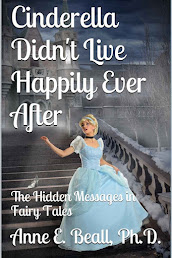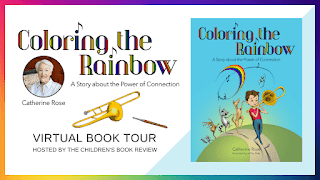Cinderella Didn't Live Happily Ever After by Anne Beall
Book Description:
Did
Cinderella live happily ever after? You might think so until you look more closely at the hidden messages in beloved fairy tales. In this book, fairy tales are analyzed in terms of the underlying messages about marriage, agency, power, suffering, and good versus evil, with a focus on how male and female characters differ in each of these areas. The analysis is a data-driven approach that provides clear evidence for the hidden messages in these beloved tales. The end conclusion is not whether fairy tales are good or bad but rather what messages they deliver about life, even if unintentionally.
Author Interview:
In your book, you found female
characters are weak and victimized by powerful people. Are there fairy tales
that don’t conform to this pattern?
Yes! One of my favorite Grimms’
Fairy Tales is Fitcher’s Bird, which is a version of Blue Beard.
In this story, a male sorcerer kidnaps individual women and brings them to his
castle to become his bride. In one home, he eventually kidnaps three sisters.
When each sister arrives at his castle, he gives her strict instructions not to
open a certain door. Each sister goes against his wishes. They discover a gory
scene: the forbidden room contains the bodies of all his previous brides. Sadly
the wizard kills the first two sisters and places each one in the terrible
room. The last sister outsmarts the evil sorceress when she’s given
instructions not to visit the room. She does so and brings her sisters back to
life. He decides to marry her, and she instructs him to take a basket of gold
back to her parents. Her sisters hide in the large basket. When the young women
return to their parents, they alert the community about what the wizard has
done. In the meantime, the youngest covers herself in feathers to disguise herself
as a bird. She leaves the castle and then locks her fiancée and his wedding
guests in the castle. She and her relatives then set his castle on fire.
Do fairy tales have any hidden
messages about marriage?
They do! Women marry kings and
princes when they are beautiful—often that is the only thing mentioned about
these women. Marriage proposals in fairy tales often occur within minutes of a
royal man meeting a beautiful woman. In contrast, men marry up for feats of
bravery and tremendous intelligence. But marriage to a king can be rough. I
found queens are the saddest—they cry more than any other character because
they’re attacked by other women who want to take their place, sometimes their
mothers-in-law are jealous of them, and in many tales their children are
kidnapped right after birth. Marriage among non-royalty doesn’t look like much
of a picnic either, with stories that feature lazy husbands and foolish wives.
In one story, Lazy Hans, a man marries a woman simply because he doesn’t
want to take his goat into the pasture, and she currently has a goat. Now she
had to take care of two goats. Not the most romantic of tales.
What are some things that have
surprised you in terms of reactions to the book?
I was shocked when People
Magazine featured the book. They came upon my finding that queens and
princesses are saddest and most fearful characters, whereas princes and kings
are the happiest ones. Kings and princes have power and get what they want,
whereas queens and princesses are often victimized and placed into terrible
situations. They’re locked away in towers and attacked by others. I was
thrilled when People discovered the book and publicized this data.
Do you think fairy tales influence
how people look at their lives?
Fairy tales are some of the first
stories we learn as children, some of the most popular movies, and some people
may long for a fairy tale life. When I was writing this book, it surprised me
how often I heard the words, “prince,” “princess,” “queen,” “king” and “fairy
tale” in everyday language. These are concepts that are strongly entrenched in
our culture. Women talk about and having a fairy-tale wedding and living
happily ever after. And many women may wish to find their prince charming. I
think it’s possible that these stories can be aspirational for many people and
that they may measure their lives against this ideal.
What else are you working on?
I’m working on a seminar called, Why Do I Sometimes Feel Like Cinderella, and Where is Prince Charming?! I’d like to educate people about some patterns in fairy tales and how these stories affect us. I’d like to show how some of the data we found may influence how one views gender, power, marriage, and good vs. evil. And I’d like to teach people how to write their own life story as a fairy tale. I believe everyone has struggled, encountered unfairness, battled powerful forces (and people), and overcome major difficulties, which is what fairy tales are all about. I’d like people to see themselves as the hero/heroine of their own fairy tale.
A leader in the field of market research and one of the few female CEOs in the industry, Anne E. Beall is the author of 10 books in business, gender studies, and mindfulness, including Cinderella Didn’t Live Happily Ever After: The Hidden Messages in Fairy Tales and The Psychology of Gender. Her book Heartfelt Connections was named one of the top 100 Notable Indie books in 2016 by Shelf Unbound, and she has published nearly a dozen business articles in noted journals. Her books have been featured in People Magazine, Toronto Sun, Hers Magazine, and Ms. Career Girl, and she has been interviewed by NBC, NPR, and WGN. Having received her PhD in social psychology from Yale University, Anne resides in Evanston, Illinois and is the founder of the market consultancy company Beall Research.
connect with the author: website ~ facebook ~ twitter ~ goodreads
Enter the Giveaway:
CINDERELLA DID NOT LIVE HAPPILY EVER AFTER Book Tour Giveaway




Thanks so much for featuring my book and for posting this lovely interview. So appreciated!!
ReplyDelete